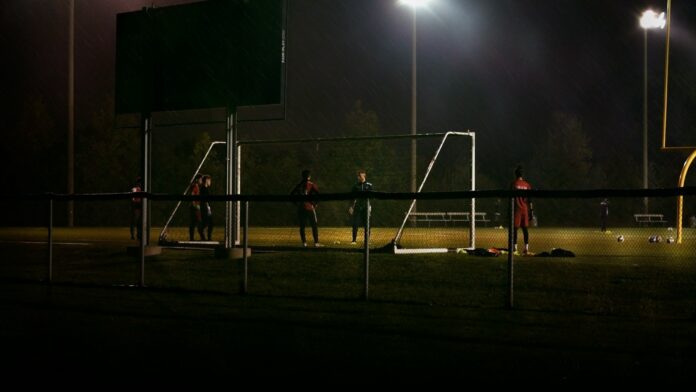The traditional image of a football goalkeeper, rooted primarily in preventing goals, is rapidly becoming outdated. In today’s dynamic and tactical game, the goalkeeper’s role has expanded dramatically, transforming them into key-players, astute communicators, and potent initiators of attacks. This fundamental shift redefines what it means to be a top-tier goalkeeper, moving beyond the historical undervaluation of the position, where sums over $100 million are frequent for outfield players but rare for goalkeepers.
From Stopper to Key-player
Modern goalkeepers are fundamental to a team’s build-up play, particularly in “building from the back”. This requires excellent footwork and passing accuracy under pressure, making their proficiency with the ball as vital as their shot-stopping ability. Since distribution is 80% of the goalkeeper actions in a game, distribution drills are no longer additional but integrated along with traditional saving exercises in every training.
Their comprehensive distribution repertoire includes:
- Goal Kicks: These initiate organized tactical plays, requiring goalkeepers to master short and long passes from a static ball. Strategic decisions based on opponent positioning and team plans are vital, as are prompt repositioning and communication after each kick.
- Back Passes: Essential technical skills include receiving and accurately passing the ball, both short and long, with both feet. Their positioning must facilitate receiving the ball with minimal pressure, enabling effective passes to overcome opponents.
- Hand Transition: This method allows for rapid counter-attack initiation. Goalkeepers need maximum precision and accuracy in their throws, rapidly scanning for optimal targets within their range to turn a save into a lightning-fast counter-attack.
- Volley Transition: Crucial for swift counter-attacks, this skill demands accuracy and power to launch long passes into advantageous areas, requiring the goalkeeper to quickly identify and target open spaces or teammates.
The Tactical “Quarterback”
Beyond technical ball skills, the modern goalkeeper is a defensive orchestrator. They must possess acute tactical awareness, continuously reading the game, anticipating opponent attacks, and organizing their defense. This leadership role involves constant communication and direction to teammates, including verbal commands (e.g., “TIME!”, “MAN ON!”, “CLEAR IT!”) and clear gestures (e.g., for wall positioning). The emergence of the “sweeper-keeper” further emphasizes their active role outside the penalty area, clearing through balls and supporting the defensive line with quick decisions and precise long passes.
Revolutionizing Training Methods
To foster these evolving skills, goalkeeper training has dramatically adapted. Sessions now emphasize dynamic, game-like scenarios that simulate match situations, promoting decision-making and adaptability over repetitive drills. Key training trends include:
- Reaction-based drills: Utilizing small, fast-moving balls or unpredictable deflection boards to sharpen reflexes.
- High-pressure simulations: Replicating real-game stress, such as penalty shootouts with loud distractions, to build mental fortitude and composure.
- Functional fitness: Focusing on explosive movements (e.g., box jumps, medicine ball throws) to enhance power for diving and rapid recoveries.
The Role of Technology
Technology is integral to this evolution. Advanced data analytics provides detailed insights into performance, allowing for personalized training and tactical adjustments based on save rates, distribution patterns, and opponent tendencies. Video analysis offers coaches a powerful tool to dissect movements, pinpoint areas for improvement, and prepare goalkeepers for specific opponents by studying their habits and preferred shooting angles. Innovations like motion capture systems, smart gloves, and predictive analytics further refine technique and anticipation.
Conclusion
The modern goalkeeper’s role has transcended merely stopping shots, becoming a multi-faceted position demanding comprehensive skills in playmaking, distribution, tactical awareness, and communication. This evolution, supported by innovative training approaches and technological advancements, underscores their indispensable contribution to every facet of the beautiful game. As football continues its relentless evolution, so too will the demands on goalkeepers, ensuring their continued importance as the “backbone of their teams”.
Here is a video example of a typical distribution training: https://youtu.be/88xn7kEuX2w
References
- Yam, D. (2025). A Data Driven Goalkeeper Evaluation Framework. MIT Sloan Sports Analytics Conference.
- rMLS (2024). Advanced Goalkeeping Statistics. r/football, Reddit. Avialable at: https://www.reddit.com/r/football/comments/1emcj9q/advanced_goalkeeping_statistics_analysis_ive_done/ Accessed on 19 July 2025
- Numazu, N., Hirashima, Y., & Matsukura, K. (2024, December). Analysis of football goalkeeper performance and shot scenarios in the 2022 World Cup. Journal of Physical Education and Sport, 24(12), 2115-2125. doi:10.7752/jpes.2024.12310.
- BC Football. (2015). Club Goalkeeping Development Manual. Available at: https://cloud.rampinteractive.com/saskatchewanfootball/files/BC-Football-Goalkeeper-Club-Development_Stages-4-7.pdf Accessed on 20 July 2025
- Berneanou, G. (2021). Football Goalkeeper Integration.
- El Assouri, A. (2024). Impact of Data and Analytics on Goalkeeper Strategies. Keeper in Motion.
- Teimouri, M. (2025, February). Football Goalkeeper Performance Evaluation: Clustering Approach. arXiv. https://doi.org/10.48550/arXiv.2502.05548
- Hugh, P. (2025, January 5). The Future of Goalkeeping: Trends and Innovations in Training. Football Wizdom.
- White, A., Hills, S. P., Hobbs, M., Cooke, C. B., Kilduff, L. P., Cook, C., Roberts, C., & Russell, M. (2020, April). The physical demands of professional football goalkeepers throughout a week-long competitive microcycle and transiently throughout match-play. Journal of Sports Sciences, 38(8), 848-854. doi:10.1080/02640414.2020.1736244.
- El Assouri, A. (2024, May). The role of video analysis in goalkeeper development. Keeper in Motion. Available at: https://keeperinmotion.com/en/2024/05/02/the-role-of-video-analysis-in-goalkeeper-development/ Accessed on 21 July 2025
- Waite, A. (2023, January). Understanding The Role Of The Goalkeeper Scout. Available at: https://goalkeeper.com/news-and-media/exclusives/post/role-of-the-goalkeeper-scout Accessed on 21 July 2025

